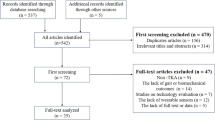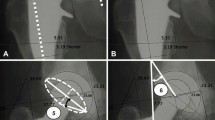Abstract
Background
Patient activity influences polyethylene wear. However, it is unclear how individual activity changes with patient aging after THA.
Questions/purposes
We quantified changes in individual gait cycles and gait speed, assessed age-related differences in these parameters, and determined their relationship to polyethylene wear.
Methods
A microprocessor was worn on the ankle to quantify the activity of 14 healthy patients with a well-functioning THA at two time periods: early (within 3.5 years of implantation) and late (10–13 postoperative years). Wear was measured on serial radiographs using edge detection-based software.
Results
Mean activity decreased by 16% from the early to the late period: 2.04 million gait cycles/year to 1.71 million gait cycles/year. Mean gait speed decreased by 9%: 15.4 cycles/minute to 14.0 cycles/minute. The activity of the 10 patients who were younger than 65 years at surgery decreased by 14% (2.34 million gait cycles/year to 2.02 million gait cycles/year), while the four patients 65 years or older at surgery decreased by 28% (1.29 million gait cycles/year to 0.94 million gait cycles/year). Gait speed was 26% slower for patients 65 years or older than for patients younger than 65 years. The mean linear penetration rate decreased by 42% from the first 5 years (early wear rate) to the next 8 years (late wear rate, 5–13 years): 0.043 mm/year to 0.025 mm/year.
Conclusions
The greatest patient activity and wear occurred during the first 5 years. Walking speed and gait cycles both decreased with aging, resulting in deceasing wear over time.





Similar content being viewed by others
References
Bitsch RG, Loidolt T, Heisel C, Ball S, Schmalzried TP. Reduction of osteolysis with use of Marathon cross-linked polyethylene: a concise follow-up, at a minimum of five years, of a previous report. J Bone Joint Surg Am. 2008;90:1487–1491.
Charnley J. The long-term results of low-friction arthroplasty of the hip performed as a primary intervention. J Bone Joint Surg Br. 1972;54:61–76.
Clarke IC, Manley MT. How do alternative bearing surfaces influence wear behavior? Implant Wear Symposium 2007: Engineering Work Group. J Am Acad Orthop Surg. 2008;16(suppl 1):S86–S93.
Dumbleton JH, Manley MT, Edidin AA. A literature review of the association between wear rate and osteolysis in total hip arthroplasty. J Arthroplasty. 2002;17:649–661.
Kurtz SM, Gawel HA, Patel JD. History and systematic review of wear and osteolysis outcomes for first-generation highly crosslinked polyethylene. Clin Orthop Relat Res. 2011;469:2262–2277.
Lachiewicz PF, Heckman DS, Soileau ES, Mangla J, Martell JM. Femoral head size and wear of highly cross-linked polyethylene at 5 to 8 years. Clin Orthop Relat Res. 2009;467:3290–3296.
Leung SB, Egawa H, Stepniewski A, Beykirch S, Engh CA Jr, Engh CA Sr. Incidence and volume of pelvic osteolysis at early follow-up with highly cross-linked and noncross-linked polyethylene. J Arthroplasty. 2007;22:134–139.
Martell JM, Berdia S. Determination of polyethylene wear in total hip replacements with use of digital radiographs. J Bone Joint Surg Am. 1997;79:1635–1641.
McKellop H, Shen FW, DiMaio W, Lancaster JG. Wear of gamma-crosslinked polyethylene acetabular cups against roughened femoral balls. Clin Orthop Relat Res. 1999;369:73–82.
McKellop HA. Laboratory wear testing. In: Callaghan JJ, Rosenberg AG, Rubash H, eds. The Adult Hip. Philadelphia, PA: JB Lippincott; 1998.
Schmalzried TP, Shepherd EF, Dorey FJ, Jackson WO, dela Rosa M, Favae F, McKellop HA, McClung CD, Martell J, Moreland JR, Amstutz HC. Wear is a function of use, not time. Clin Orthop Relat Res. 2000;381:36–46.
Schmalzried TP, Szuszczewicz ES, Northfield MR, Akizuki KH, Frankel RE, Belcher G, Amstutz HC. Quantitative assessment of walking activity after total hip or knee replacement. J Bone Joint Surg Am. 1998;80:54–59.
Shepherd EF, Toloza E, McClung CD, Schmalzried TP. Step activity monitor (SAM): increased accuracy in quantifying ambulatory activity. J Orthop Res. 1999;17:703–708.
Silva M, McClung CD, dela Rosa MA, Dorey FJ, Schmalzried TP. Activity sampling in the assessment of patients with total joint arthroplasty. J Arthroplasty. 2005;20:487–491.
Silva M, Shepherd EF, Jackson WO, Dorey FJ, Schmalzried TP. Average patient walking activity approaches 2 million cycles per year: pedometers under-record walking activity. J Arthroplasty. 2002;17:693–697.
Acknowledgments
The authors acknowledge and thank Dr. John Martell for his assistance with the radiographic wear analysis.
Author information
Authors and Affiliations
Corresponding author
Additional information
The institution of one of the authors (TPS) has received funding, during the study period, from the Piedmont Foundation (Rolling Hills, CA, USA)
All ICMJE Conflict of Interest Forms for authors and Clinical Orthopaedics and Related Research editors and board members are on file with the publication and can be viewed on request.
Clinical Orthopaedics and Related Research neither advocates nor endorses the use of any treatment, drug, or device. Readers are encouraged to always seek additional information, including FDA approval status, of any drug or device before clinical use.
Each author certifies that his or her institution approved the human protocol for this investigation, that all investigations were conducted in conformity with ethical principles of research, and that informed consent for participation in the study was obtained.
This work was performed at St Vincent Medical Center, Los Angeles, CA, USA.
About this article
Cite this article
Battenberg, A.K., Hopkins, J.S., Kupiec, A.D. et al. The 2012 Frank Stinchfield Award: Decreasing Patient Activity With Aging: Implications for Crosslinked Polyethylene Wear. Clin Orthop Relat Res 471, 386–392 (2013). https://doi.org/10.1007/s11999-012-2497-y
Published:
Issue Date:
DOI: https://doi.org/10.1007/s11999-012-2497-y




